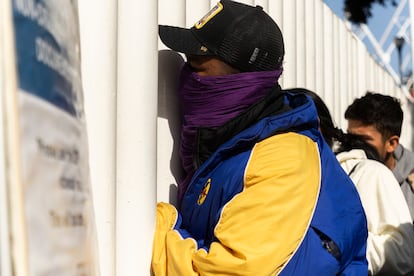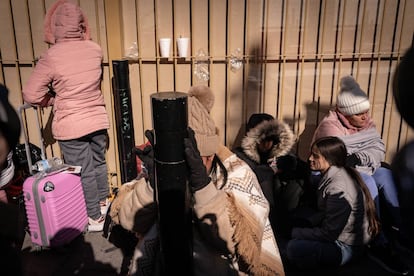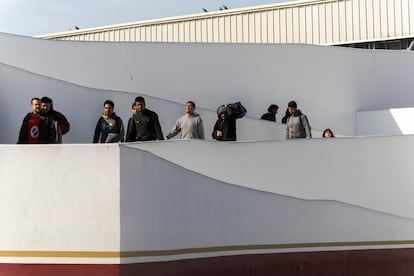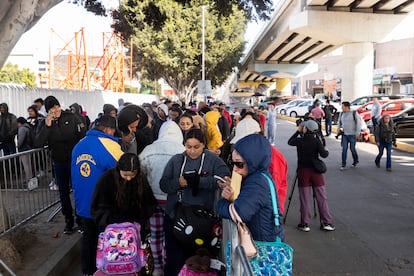Migrants trapped on the Mexican border: ‘I don’t know what will become of us’
Thousands of people are in limbo as the CBP One asylum application is shut down on the first day of the Donald Trump administration

For just one day, Odalys Fundicheli and her granddaughter Lía have been trapped in a limbo from which almost no one yet knows how to escape. Fundicheli, 62, comes from Cuba and had an appointment to cross the border into the United States through Tijuana this Tuesday. On the other side, her family was waiting for her. But CBP One, the application that the U.S. government opened to manage entries in a regulated manner, has ceased to exist after the inauguration of Donald Trump. One day before her turn, everything has collapsed and all appointments have been canceled. “We feel very frustrated and helpless,” says Fundicheli, while her 14-year-old granddaughter cries next to her. “We were going to meet up with my daughter who lives in Dallas, but they say the application is canceled. I don’t know what will become of us, it is the first time we have left Cuba.” Like them, thousands of people have been left stranded since Monday on the border between Mexico and the United States.
Trump was still speaking during his inaugural address when on the other side of the border the future of thousands of migrants was evaporating. The president made good on his threats to eliminate CBP One and the asylum request systems before even finishing the presentation of his new government. Thousands of people have thus seen their American dream end before it even begins. All of them are now left in a defenseless situation in Mexican territory, where some have permission to transit the country for 20 days, and many others not even that.
Only a few hours made the difference. Early Monday morning, the last groups of migrants under the Biden administration crossed into the United States. José Louiza was on the next shift, the 1 p.m. shift. He lined up with his wife and 13-year-old son. They had a printed confirmation of their appointment, and each one, a cloth backpack. They waited patiently and quietly in the sub-zero cold of Ciudad Juárez while the hours passed. A little before 11 a.m. the notice arrived: “The existing scheduled appointments for CBP One are no longer valid.” After reading it, his wife threw herself desperately to the ground, in a gesture that captures the helplessness behind nine months of travel, the effort of crossing a jungle and six countries, to be just one step away: “It is not human,” summarizes Louiza, who was a fisherman in Venezuela.
The collapse of this system has been a blow to the spirit of migrants. Thousands of people entered the application every day hoping to be chosen for an interview at one of the eight border crossing points. With that hope they endured extortion and kidnappings, precarious, poorly paid jobs, hunger, cold, and fear. With that hope they also avoided illegal crossings and paying coyotes to help them enter the U.S. without papers. “Crime is going to benefit from all this, without a doubt,” sums up Juan Fierro, pastor of the El Buen Samaritano shelter in Ciudad Juárez.
In the border town, everything was calm until today, when a sadness descended on migrants. The groups are splitting up, some going to churches and soup kitchens, others to the checkpoints on the bridges. The plea is the same: “Excuse me, we are looking for guidance.” No one knows for sure what options they have left. For the moment, there are very few. Trump has announced that he is going to reestablish the Remain in Mexico (MPP) program, which forces migrants to wait on Mexican soil for an appointment to continue their asylum process. It is a long and costly process that already resulted in problems in 2019 and with which Claudia Sheinbaum’s government has not yet said it agrees.

With this measure, Trump thus transfers the management of the migration crisis to the Mexican government, which will also have to deal with the waves of Mexican deportees (it remains to be seen what will happen to migrants from other countries). The new president added fuel to the fire Monday, when he declared a national emergency on the southern border to, among other measures, reinforce it with the presence of the army.
Entire families thought that on Monday, they would still have a chance to get to the other side. This was the case of Giovanni, 38, and his wife Narkys, 37, originally from Venezuela. The couple were waiting in front of the entrance to the El Chaparral border crossing in Tijuana. “Right now you feel so many things,” Giovanni said with resignation and great sadness. “If you knew everything we went through to get here…” He and his wife left Caracas over a year ago and were waiting in Tapachula for their appointment. It was scheduled on January 20 at 1 p.m. “We just got an email saying that all the appointments were canceled.” They still don’t know what they will do, because they spent all their money to travel to the border. The same scene of desolation was repeated Monday from Tijuana to Matamoros, at the eight points of entry where the 1,450 daily CBP One appointments were processed.

Trump’s MPP proposal was previously implemented in 2019. During the time it was active, until Joe Biden ended it in 2022, more than 71,000 migrants were forced to stay on Mexican soil until they received a response to their asylum application, according to data from the Washington Office on Latin America (WOLA). That influx of migrants was handled in a very precarious manner by Mexico, with overcrowding, unsanitary conditions, and insecurity for thousands of people.
“[The implementation of MPP] is a unilateral decision that they have made, we do not necessarily share it and we have a different approach, but we are finding the adjustment mechanisms, of course it does not imply obligations for Mexico, some agreements can be reached,” said Foreign Secretary Juan Ramón de la Fuente at a press conference Monday. In addition to this measure, the Mexican government will have to deal with the mass deportations announced by Trump. The incoming president has threatened to deport millions of undocumented people to Mexico.
“I am afraid of what could happen now,” says Father Pat Murphy, director of the Casa del Migrante in Tijuana. The shelter currently has a maximum capacity of 180 people, but he fears that there will soon not be enough space: “People keep coming from the south and they are going to deport a lot of people from the north. I fear that there will be a migration crisis worse than the one we are already experiencing.”
The Mexican government has assured that it is preparing for the massive arrival of migrants. However, local authorities are concerned. The city of Tijuana issued an alert last week: “We have to take Donald Trump’s threats seriously and take the necessary measures,” José Luis Pérez Canchola, head of Immigration for the Tijuana City Council, told EL PAÍS. He insists on coordinated work with federal authorities.
In Tijuana there are 44 shelters, most of them run by churches of different faiths, with total capacity for about 5,000 people. The municipal government is opening a new shelter with space for another 3,000 people. In Ciudad Juárez, Enrique Serrano, general coordinator of the State Population Council, is committed to seeking dialogue with the U.S. side: “There is no official information on a deportation schedule. We know it will happen, but we don’t know when, where, or how many. We hope that Mexican diplomacy will come to an agreement with the U.S. government to carry out scheduled deportations agreed upon with the Mexican government, so that we can attend to that population.” For the time being, a camp with tents will be built on land near the wall that separates the country from El Paso, Texas, to accommodate 5,000 people.
For its part, Sheinabum’s government will launch the ‘Mexico embraces you’ plan, which will offer comprehensive care to Mexican migrants arriving from the United States. The president assured her compatriots that they are not alone. “When they arrive in Mexico, there is a program that includes support from the Welfare Department, admission to the IMSS (social security system), support for employment, transportation so they can get to their places of origin, and a small initial grant if they arrive without resources,” the president explained on Monday.

Sign up for our weekly newsletter to get more English-language news coverage from EL PAÍS USA Edition
Tu suscripción se está usando en otro dispositivo
¿Quieres añadir otro usuario a tu suscripción?
Si continúas leyendo en este dispositivo, no se podrá leer en el otro.
FlechaTu suscripción se está usando en otro dispositivo y solo puedes acceder a EL PAÍS desde un dispositivo a la vez.
Si quieres compartir tu cuenta, cambia tu suscripción a la modalidad Premium, así podrás añadir otro usuario. Cada uno accederá con su propia cuenta de email, lo que os permitirá personalizar vuestra experiencia en EL PAÍS.
¿Tienes una suscripción de empresa? Accede aquí para contratar más cuentas.
En el caso de no saber quién está usando tu cuenta, te recomendamos cambiar tu contraseña aquí.
Si decides continuar compartiendo tu cuenta, este mensaje se mostrará en tu dispositivo y en el de la otra persona que está usando tu cuenta de forma indefinida, afectando a tu experiencia de lectura. Puedes consultar aquí los términos y condiciones de la suscripción digital.
More information
Archived In
Últimas noticias
Most viewed
- Reinhard Genzel, Nobel laureate in physics: ‘One-minute videos will never give you the truth’
- Oona Chaplin: ‘I told James Cameron that I was living in a treehouse and starting a permaculture project with a friend’
- Pablo Escobar’s hippos: A serious environmental problem, 40 years on
- Why we lost the habit of sleeping in two segments and how that changed our sense of time
- Charles Dubouloz, mountaineering star, retires at 36 with a farewell tour inspired by Walter Bonatti










































